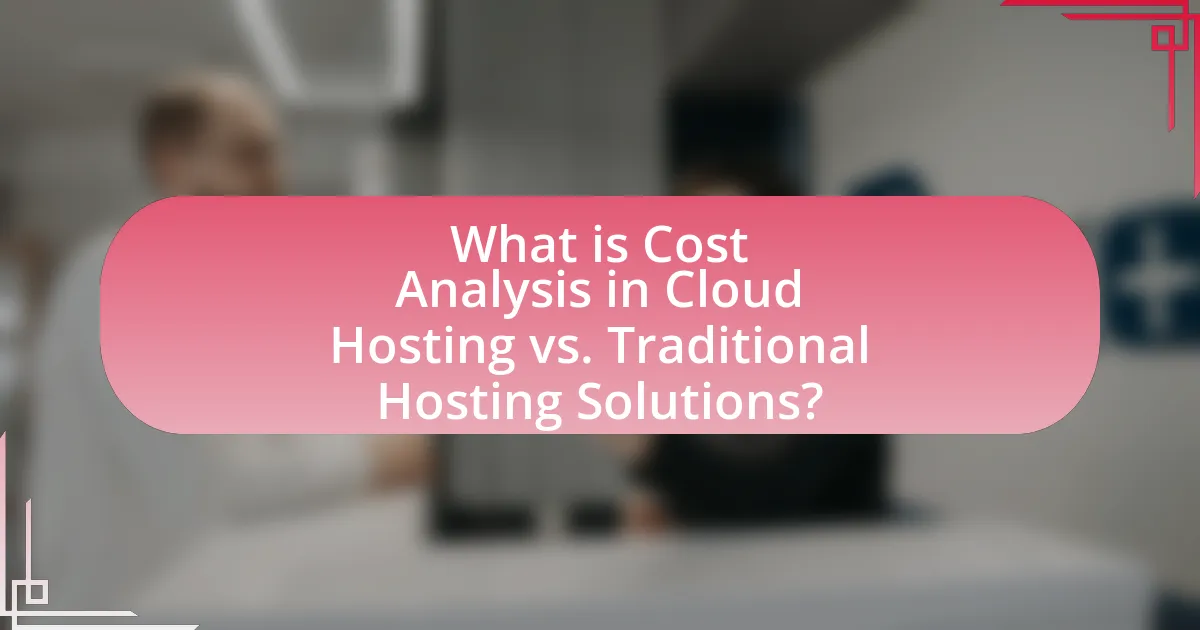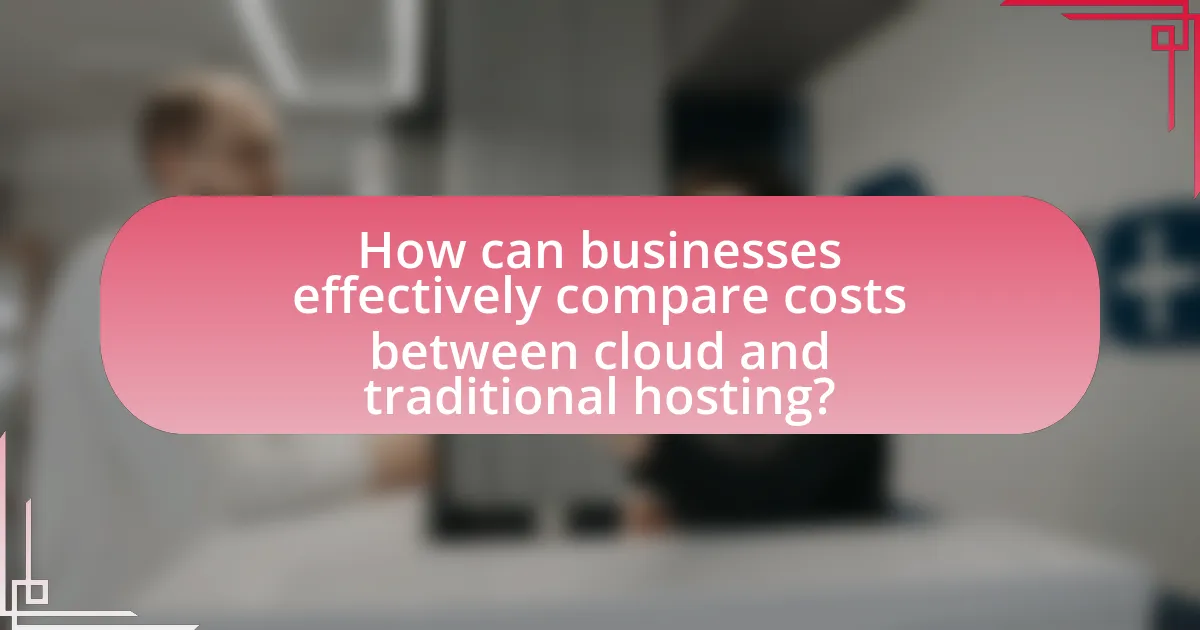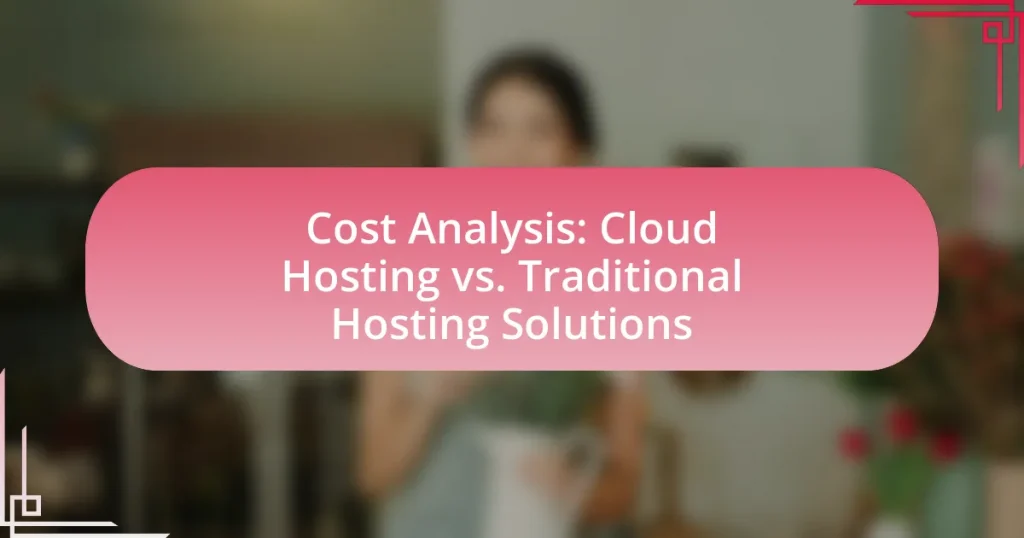Cost analysis in cloud hosting versus traditional hosting solutions evaluates the total expenses associated with each model to determine cost-effectiveness. Cloud hosting typically features lower upfront costs and operates on a pay-as-you-go model, allowing for scalability and potential savings, while traditional hosting often requires significant initial investments in hardware and ongoing maintenance. Key factors influencing costs include infrastructure, scalability, resource allocation, and management, with studies indicating that businesses can save up to 30% on IT costs by migrating to cloud solutions. The article will explore the differences in initial setup and ongoing operational costs, the impact of scalability, and the importance of conducting a thorough cost analysis to make informed financial decisions regarding hosting options.

What is Cost Analysis in Cloud Hosting vs. Traditional Hosting Solutions?
Cost analysis in cloud hosting versus traditional hosting solutions involves evaluating the total expenses associated with each model to determine cost-effectiveness. Cloud hosting typically operates on a pay-as-you-go model, which can lead to lower upfront costs and scalability, while traditional hosting often requires significant initial investments in hardware and ongoing maintenance costs. For instance, a study by Gartner indicates that businesses can save up to 30% on IT costs by migrating to cloud solutions, highlighting the financial advantages of cloud hosting over traditional methods.
How do cloud hosting and traditional hosting differ in terms of cost?
Cloud hosting typically incurs lower upfront costs compared to traditional hosting, which often requires significant initial investments in hardware and infrastructure. In traditional hosting, businesses must purchase and maintain physical servers, leading to higher capital expenditures. Conversely, cloud hosting operates on a pay-as-you-go model, allowing users to pay only for the resources they consume, which can lead to cost savings, especially for businesses with fluctuating demands. Additionally, cloud hosting eliminates the need for extensive maintenance and upgrades, further reducing ongoing operational costs.
What are the initial setup costs for cloud hosting compared to traditional hosting?
Initial setup costs for cloud hosting are generally lower than those for traditional hosting. Cloud hosting typically requires minimal upfront investment, as it operates on a pay-as-you-go model, allowing users to scale resources according to their needs without significant initial expenditures. In contrast, traditional hosting often necessitates substantial upfront costs for hardware, software, and infrastructure setup, which can range from thousands to tens of thousands of dollars. For example, a study by Gartner indicates that businesses can save up to 30% on initial costs by opting for cloud solutions over traditional setups.
How do ongoing operational costs vary between cloud and traditional hosting?
Ongoing operational costs for cloud hosting are generally lower and more flexible compared to traditional hosting. Cloud hosting typically operates on a pay-as-you-go model, allowing businesses to scale resources up or down based on demand, which can lead to cost savings. In contrast, traditional hosting often requires fixed monthly fees regardless of usage, leading to potential overpayment for unused resources. For example, a study by Gartner indicates that organizations can save up to 30% on IT costs by migrating to cloud solutions due to reduced hardware expenses and maintenance costs associated with traditional hosting.
What factors influence the cost of cloud hosting and traditional hosting?
The cost of cloud hosting and traditional hosting is influenced by several key factors, including infrastructure, scalability, resource allocation, and management. Infrastructure costs for traditional hosting typically involve physical servers, maintenance, and data center expenses, while cloud hosting relies on virtualized resources that can be dynamically allocated, often leading to lower upfront costs. Scalability in cloud hosting allows users to pay only for the resources they consume, which can reduce costs during low-demand periods, whereas traditional hosting often requires fixed pricing regardless of usage. Resource allocation in cloud hosting is flexible, enabling efficient use of computing power, while traditional hosting may involve over-provisioning to meet peak demands, increasing costs. Management costs also differ; cloud hosting often includes automated management tools, reducing the need for extensive IT staff, while traditional hosting may require more hands-on management and support.
How does scalability impact the overall cost of cloud hosting?
Scalability significantly impacts the overall cost of cloud hosting by allowing businesses to adjust their resources based on demand, which can lead to cost savings. When a company experiences increased traffic, it can scale up its resources in real-time, paying only for what it uses, rather than investing in excess capacity that may remain idle. For example, a study by Gartner indicates that organizations can save up to 30% on IT costs by utilizing scalable cloud solutions compared to traditional hosting, which often requires fixed investments in hardware and infrastructure. This flexibility not only optimizes operational expenses but also enhances budget predictability, as costs align more closely with actual usage.
What role do maintenance and support costs play in traditional hosting expenses?
Maintenance and support costs are significant components of traditional hosting expenses, often accounting for a substantial portion of the overall budget. These costs include regular server upkeep, software updates, security patches, and technical support, which are essential for ensuring optimal performance and reliability. For instance, a study by Gartner indicates that maintenance and support can represent up to 20-30% of total IT spending in traditional hosting environments. This highlights the financial impact of these costs on businesses relying on traditional hosting solutions, as they must allocate resources not only for initial setup but also for ongoing operational support.
Why is it important to conduct a cost analysis for hosting solutions?
Conducting a cost analysis for hosting solutions is crucial because it enables businesses to make informed financial decisions regarding their hosting options. By evaluating the total cost of ownership, including initial setup, ongoing maintenance, and potential scalability costs, organizations can identify the most cost-effective solution that meets their needs. For instance, a study by Gartner indicates that cloud hosting can reduce IT costs by up to 30% compared to traditional hosting, highlighting the financial benefits of thorough cost analysis. This analysis also helps in forecasting future expenses and aligning hosting choices with budget constraints, ultimately leading to better resource allocation and financial planning.
How can a cost analysis help businesses make informed decisions?
A cost analysis helps businesses make informed decisions by providing a detailed breakdown of expenses associated with different options, such as cloud hosting versus traditional hosting solutions. This analysis enables businesses to compare the total cost of ownership, including initial setup, ongoing maintenance, and potential scalability costs. For instance, a study by Gartner indicates that cloud solutions can reduce IT costs by up to 30% compared to traditional hosting, allowing businesses to allocate resources more effectively. By evaluating these financial implications, companies can choose the most cost-effective solution that aligns with their operational needs and budget constraints.
What are the potential risks of not performing a cost analysis?
Not performing a cost analysis can lead to significant financial risks, including overspending and misallocation of resources. Without a thorough evaluation of costs, organizations may choose cloud hosting or traditional hosting solutions that do not align with their budgetary constraints, resulting in unexpected expenses. For instance, a study by Gartner indicates that companies can overspend on cloud services by up to 30% due to a lack of cost visibility and management. Additionally, failing to analyze costs can hinder strategic decision-making, leading to missed opportunities for savings or investment in more efficient technologies.

What are the key components of cost analysis for hosting solutions?
The key components of cost analysis for hosting solutions include initial setup costs, ongoing operational expenses, scalability options, and potential downtime costs. Initial setup costs encompass hardware, software, and configuration expenses, which can vary significantly between cloud and traditional hosting. Ongoing operational expenses involve monthly fees, maintenance, and support, with cloud solutions often providing pay-as-you-go pricing models that can lead to cost savings. Scalability options refer to the ability to adjust resources based on demand, which is typically more flexible in cloud hosting, potentially reducing costs during low-usage periods. Lastly, potential downtime costs represent the financial impact of service interruptions, which can be more pronounced in traditional hosting environments due to less redundancy and support.
What are the direct costs associated with cloud hosting?
The direct costs associated with cloud hosting include subscription fees, data transfer charges, storage costs, and additional service fees for features like backups and security. Subscription fees are typically charged on a monthly or annual basis, varying by provider and service level. Data transfer charges apply when moving data in and out of the cloud, often calculated per gigabyte. Storage costs depend on the amount of data stored and the type of storage used, such as standard or premium options. Additional service fees may arise for optional features, including enhanced security measures or automated backups, which can further impact the overall cost.
How do subscription models affect the cost of cloud hosting?
Subscription models significantly reduce the upfront costs of cloud hosting by allowing users to pay for services on a recurring basis rather than making a large initial investment. This model enables businesses to manage their cash flow more effectively, as they can allocate funds monthly or annually based on their usage and needs. According to a report by Gartner, organizations that adopt subscription-based cloud services can save up to 30% on total IT costs compared to traditional hosting solutions, which often require substantial capital expenditures for hardware and software. Additionally, subscription models typically include maintenance and support, further lowering the total cost of ownership for businesses.
What additional fees should be considered in cloud hosting costs?
Additional fees to consider in cloud hosting costs include data transfer fees, storage costs, and support charges. Data transfer fees are incurred when moving data in and out of the cloud, often charged per gigabyte. Storage costs can vary based on the type of storage used, such as standard or premium options, and may include costs for backups and redundancy. Support charges may arise from opting for premium support services, which can significantly increase overall expenses. According to a report by Gartner, organizations can face up to 30% of their cloud budget in unexpected costs, emphasizing the importance of understanding these additional fees.
What are the direct costs associated with traditional hosting?
The direct costs associated with traditional hosting include server hardware, data center space, power consumption, cooling systems, and maintenance fees. Server hardware typically requires a significant upfront investment, often ranging from several hundred to thousands of dollars depending on specifications. Data center space incurs monthly rental fees, which can vary based on location and size, while power consumption and cooling systems contribute to ongoing operational expenses. Maintenance fees, including technical support and software updates, further add to the total cost of traditional hosting. These costs can accumulate quickly, making traditional hosting potentially more expensive than cloud hosting solutions, which often offer more flexible pricing models.
How do hardware and software costs impact traditional hosting expenses?
Hardware and software costs significantly impact traditional hosting expenses by constituting a large portion of the overall expenditure. Traditional hosting requires physical servers, networking equipment, and software licenses, which incur upfront capital costs and ongoing maintenance expenses. For instance, a dedicated server can cost between $100 to $500 per month, depending on specifications, while software licenses for operating systems and applications can add hundreds to thousands of dollars annually. Additionally, the need for IT personnel to manage and maintain this infrastructure further increases costs, with salaries averaging around $80,000 per year for system administrators. Therefore, the cumulative effect of hardware and software costs directly influences the financial viability of traditional hosting solutions.
What are the implications of long-term contracts in traditional hosting?
Long-term contracts in traditional hosting typically lead to cost predictability and potential savings, but they also impose inflexibility and risk of obsolescence. These contracts often lock customers into fixed pricing for extended periods, which can stabilize budgeting and reduce costs compared to month-to-month arrangements. However, the commitment can hinder the ability to adapt to changing technology or market conditions, as customers may be stuck with outdated services or unable to switch providers without incurring penalties. Additionally, the average length of these contracts, often ranging from one to three years, can result in missed opportunities for better pricing or features available in the rapidly evolving hosting landscape.
How do indirect costs factor into the overall cost analysis?
Indirect costs significantly impact overall cost analysis by influencing the total expenditure associated with a project or service. In the context of cloud hosting versus traditional hosting solutions, indirect costs include expenses such as administrative overhead, utilities, and maintenance that are not directly tied to a specific service but contribute to the overall operational budget. For instance, a study by the National Institute of Standards and Technology (NIST) highlights that indirect costs can account for up to 30% of total project costs in IT environments. This means that when evaluating cloud hosting, organizations must consider these indirect costs alongside direct costs like subscription fees or hardware purchases to achieve a comprehensive understanding of the financial implications.
What are the hidden costs of cloud hosting that businesses should be aware of?
The hidden costs of cloud hosting that businesses should be aware of include data transfer fees, storage costs, and potential overage charges. Data transfer fees can accumulate when large amounts of data are moved in and out of the cloud, often leading to unexpected expenses. Storage costs can increase significantly if businesses require additional space beyond the initial allocation, as many providers charge based on usage. Additionally, overage charges may apply if a business exceeds its plan limits, resulting in higher monthly bills. According to a report by the Cloud Industry Forum, 30% of businesses experience unexpected costs related to cloud services, highlighting the importance of understanding these potential financial implications.
How can downtime affect the cost of both cloud and traditional hosting?
Downtime significantly increases costs for both cloud and traditional hosting by leading to lost revenue, decreased productivity, and potential damage to reputation. For traditional hosting, businesses may incur direct costs from service interruptions, such as lost sales during outages, which can be substantial; for instance, a study by Gartner estimates that downtime can cost businesses an average of $5,600 per minute. In cloud hosting, while costs may vary based on the service provider, downtime can still result in lost transactions and customer dissatisfaction, impacting subscription renewals and overall profitability. Additionally, cloud providers often charge for resources that remain allocated during downtime, further inflating costs. Therefore, both hosting types face financial repercussions from downtime, affecting their overall cost-effectiveness.

How can businesses effectively compare costs between cloud and traditional hosting?
Businesses can effectively compare costs between cloud and traditional hosting by analyzing total cost of ownership (TCO), which includes initial setup, ongoing operational expenses, and scalability needs. TCO for traditional hosting often involves hardware purchases, maintenance, and energy costs, while cloud hosting typically operates on a pay-as-you-go model, reducing upfront investments. According to a study by Gartner, organizations can save up to 30% on infrastructure costs by switching to cloud solutions, highlighting the financial benefits of cloud hosting. Additionally, businesses should consider factors such as performance, reliability, and support costs to gain a comprehensive understanding of the financial implications of each hosting option.
What tools and methods can be used for cost comparison?
Cost comparison can be effectively conducted using tools such as cost calculators, spreadsheets, and financial modeling software, along with methods like total cost of ownership (TCO) analysis and return on investment (ROI) analysis. Cost calculators, like those provided by cloud service providers, allow users to input specific parameters to estimate costs accurately. Spreadsheets enable detailed breakdowns of expenses, facilitating side-by-side comparisons. Financial modeling software can simulate various scenarios to project costs over time. TCO analysis considers all direct and indirect costs associated with a solution, while ROI analysis evaluates the financial return relative to the investment made. These tools and methods are widely recognized for their effectiveness in providing a comprehensive view of costs associated with different hosting solutions.
How do cost calculators assist in comparing hosting solutions?
Cost calculators assist in comparing hosting solutions by providing a structured way to evaluate the total costs associated with different options. They allow users to input specific parameters such as bandwidth, storage, and additional features, generating a clear breakdown of expenses for each hosting solution. This enables users to make informed decisions based on quantifiable data rather than subjective assessments. For instance, a study by HostingAdvice found that using cost calculators can reduce decision-making time by up to 30%, as they streamline the comparison process and highlight the most cost-effective options available.
What metrics should be considered when comparing costs?
When comparing costs, key metrics to consider include total cost of ownership (TCO), operational expenses (OPEX), capital expenses (CAPEX), scalability costs, and downtime costs. TCO encompasses all direct and indirect costs associated with a hosting solution over its lifecycle, providing a comprehensive view of financial impact. OPEX refers to ongoing costs for running the service, while CAPEX involves initial investments in hardware and infrastructure. Scalability costs assess how expenses change as demand increases, and downtime costs quantify potential revenue loss due to service interruptions. These metrics enable a thorough evaluation of financial implications between cloud hosting and traditional hosting solutions.
What are the common pitfalls in cost analysis for hosting solutions?
Common pitfalls in cost analysis for hosting solutions include overlooking hidden costs, failing to account for scalability, and not considering long-term expenses. Hidden costs, such as data transfer fees and additional service charges, can significantly inflate the total cost of ownership. Additionally, many organizations underestimate the importance of scalability; as demand grows, costs can rise unexpectedly if the hosting solution cannot efficiently accommodate increased traffic. Lastly, focusing solely on initial setup costs without evaluating ongoing operational expenses can lead to budget overruns, as maintenance, support, and potential upgrades may not be factored into the initial analysis.
How can businesses avoid underestimating costs in cloud hosting?
Businesses can avoid underestimating costs in cloud hosting by conducting thorough cost assessments that include all potential expenses. This involves analyzing not only the base pricing of cloud services but also considering factors such as data transfer fees, storage costs, and potential overage charges. According to a report by Gartner, organizations often overlook hidden costs, which can lead to a 30% increase in expected expenses. By utilizing cost calculators provided by cloud service providers and regularly reviewing usage patterns, businesses can gain a clearer understanding of their financial commitments and adjust their budgets accordingly.
What mistakes should be avoided when analyzing traditional hosting costs?
When analyzing traditional hosting costs, one should avoid overlooking hidden fees, which can significantly inflate the total cost. Many providers advertise low base prices but fail to disclose additional charges for bandwidth, storage, or technical support. Additionally, failing to consider scalability can lead to underestimating future costs; as business needs grow, the expenses associated with upgrading resources can be substantial. Another mistake is neglecting to evaluate the total cost of ownership, which includes not only the hosting fees but also maintenance, hardware, and potential downtime costs. Lastly, not comparing service level agreements (SLAs) can result in choosing a provider that does not meet reliability or performance expectations, leading to unexpected costs in the long run.
What best practices should businesses follow for cost analysis?
Businesses should follow several best practices for cost analysis to ensure accurate financial assessments. First, they should establish clear objectives for the analysis, focusing on specific cost drivers and outcomes. This clarity helps in identifying relevant data and metrics. Second, businesses must gather comprehensive data, including fixed and variable costs, to create a complete picture of expenses. Utilizing historical data can enhance accuracy, as evidenced by studies showing that data-driven decisions lead to 5-6% higher profitability.
Third, employing standardized methodologies, such as Activity-Based Costing (ABC), allows for more precise allocation of costs to products or services, improving decision-making. Research indicates that companies using ABC can reduce costs by 20-30% by identifying inefficiencies. Fourth, regular reviews and updates of cost analysis processes are essential to adapt to changing market conditions and business strategies. Finally, involving cross-functional teams in the analysis fosters diverse perspectives and insights, leading to more robust conclusions.
How can regular reviews of hosting costs improve financial management?
Regular reviews of hosting costs enhance financial management by identifying unnecessary expenses and optimizing resource allocation. By systematically analyzing hosting expenditures, organizations can pinpoint areas where costs exceed industry benchmarks or where services are underutilized. For instance, a study by Gartner indicates that companies can save up to 30% on cloud services by regularly assessing their usage and adjusting their plans accordingly. This proactive approach not only reduces waste but also allows businesses to reallocate funds to more strategic initiatives, ultimately improving overall financial health.
What strategies can help optimize hosting costs over time?
To optimize hosting costs over time, businesses should implement strategies such as utilizing cloud services with pay-as-you-go pricing, regularly reviewing resource usage, and leveraging auto-scaling features. Pay-as-you-go pricing allows companies to only pay for the resources they actually use, which can significantly reduce costs compared to traditional hosting models that often require fixed monthly fees regardless of usage. Regularly reviewing resource usage helps identify underutilized resources that can be downsized or eliminated, further lowering expenses. Additionally, auto-scaling features enable automatic adjustment of resources based on demand, ensuring that businesses only incur costs for the capacity they need at any given time. These strategies are supported by industry reports indicating that companies adopting cloud solutions can reduce their IT costs by up to 30% through efficient resource management and flexible pricing models.















